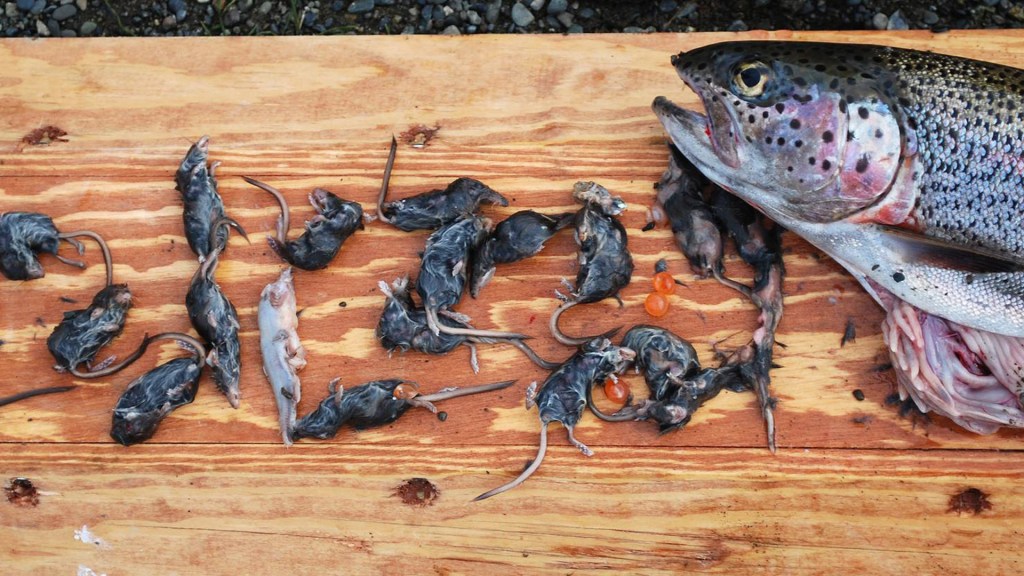Look out giant panda babies. In the realm of online wildlife stars, it’s clear that really big trout are rising – if you’ll pardon the pun – in popularity.
Particularly when those trout gobble up small, furry creatures.
The recent shrew-eating trout blog was one of the most popular we’ve ever run on Cool Green Science. It has been shared widely on social media and has been featured on everything from the Huffington Post to the Christian Science Monitor to Field & Stream.
My inbox has been filled with folks interested in trout, shrews and Togiak National Wildlife Refuge. A few more details and some speculation have emerged since I posted this photo.
Many readers wondered what species of shrew the trout ate. There was speculation that perhaps it was a water shrew—a fascinating critter that hunts caddis larvae and other prey along the bottom of streams. This species has long fascinated naturalists. (Theodore Roosevelt observed one of these shrews while on an Idaho caribou hunting trip).
However, water shrews are not found on Togiak. There are four species on the refuge: common, tundra, pygmy and Alaska tiny. There has not been confirmation of the species found in the trout stomach, but due to abundance, they were likely either common or tundra shrews.
But why shrews? I appreciate the many theories I’ve received via email, even the ones suggesting this is a fake photo (it’s not). While some media reports have claimed that mammal eating is a rare trait among fish, that is not the case. Trout are opportunistic and will feed on any small prey. What is unusual is that this one stuffed so many in its stomach.
Terry Fuller, education specialist with the Togiak National Wildlife Refuge, spoke with refuge biologist Pat Walsh and sent me the following message.
He [Walsh] said that for whatever reason shrews get targeted far more than other small mammals. He said shrews are frequently found in fish on the refuge, far more so than voles (for example) even though voles are much more abundant than shrews. He said they don’t have an explanation for why that would be but it certainly the case. Both inhabit the same places and both wind up swimming from time to time but it seems to be the shrews that fish tee off on.
Fuller then passed on to me an idea from a nearby fishing lodge:
I have another shrew/trout tidbit for you. My supervisor was speaking to the manager of one of the bigger lodges in our area. He used to guide on the Kanektok. I guess he saw the photo and said that he and the other guides use to study the small mammals, trying to get a feel for the why of it all with regards to small mammals and trout. The voles apparently swim very well but the shrews do not swim well at all. He said the shrews flounder and eventually succumb in many cases. He thinks that many of the shrews that are eaten are taken after they drown. Nothing scientific here, but supposedly this was witnessed between 50 and 100 times.
So perhaps shrews are ending up as trout prey because they’re poor swimmers.
Vladimir Dinets, a biologist, global adventurer and small mammal expert, wrote the following on the Mammal Watching Blog that expanded upon this idea:
Shrews have negative buoyancy and drown easily. I think that’s what allowed so many aquatic shrews to evolve: they have no problem diving, even with a lot of air trapped in the fir. Siberian taimen (giant relatives of salmon) also often have shrews in their stomachs.
I’ve received many other anecdotes, including a variety of instances of trout and other freshwater fish gulping up voles, shrews, ducklings and other small critters. One reader claimed to find 14 shrews in the stomach of an Arctic grayling. And then there’s a perhaps even more disturbing photo and story from the U.S. Fish and Wildlife Service in Alaska: a verified case of pike eating a bald eagle chick!
Most importantly, I think the blog shows that people are still fascinated with the many mysteries of the natural world. While technology certainly aids in our understanding of conservation biology, there’s still an important place for old-fashioned outdoor observation. Keep those stories coming, and be sure to check back to Cool Green Science frequently for more bizarre stories from the natural world.
Opinions expressed on Cool Green Science and in any corresponding comments are the personal opinions of the original authors and do not necessarily reflect the views of The Nature Conservancy.




Trout diets become extremely small during the winter months and taking on as much as possible during good feeding times enables them to survive the hard times, I am not at all surprised.